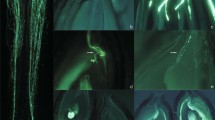Summary
In order to measure differences in the pollen growth rate of numerous lines of maize and to investigate the main features of their genetic control, gametophyte growth was studied in vitro and in vivo.
In vitro pollen tube growth of twenty inbred lines and seven hybrids was measured; a remarkable variability was observed in the growth rate of the inbred lines examined: most lines were distinct, showing different levels of growth.
Analysis of frequency distribution of pollen tube lengths for pairs of inbred lines and their F1′ s revealed greater variance among lengths of F1 pollen tubes, presumably indicating the segregation of genetic factors expressed in the gametophyte.
Similar frequency distributions of tube lengths in pollen produced by two pairs of reciprocal hybrids virtually excluded the presence of a cytoplasmic component.
In vivo competitive ability of pollen tubes was measured as the increase in relative fertilization frequency from apex to base of the ear. Mixtures were made using two types of genetically distinguishable pollen, and were applied to a female common parent. Nine pairs of inbred lines furnished the pollen for the mixtures. In all cases where the B14 line was involved, this pollen type fertilized nearly all the ovules, perhaps indicating the presence of a gametophytic factor. When other lines were compared, the ears contained mixtures of the two possible seed types, the relative proportions of which indicated the differential competitive abilities of the two pollen tube types.
A comparison between in vitro and in vivo behavior was made for some genotypes. In vivo results generally agreed with in vitro results. The degree of the differences between lines however was changed, presumably because pollen-style or pollen-pollen interactions are absent in vitro.
Differing growth patterns between lines were also revealed in vivo by direct observation of fluorescent pollen tubes within the silks, a finding which may be useful in further studies.
Similar content being viewed by others
Literature
Barnes, D.K.; Cleveland, R.W.: Genetic evidence for nonrandom fertilization in Alfalfa as influenced by differential pollen tube growth. Crop Sci. 3, 295–297 (1963)
Bianchi, A.: Ga factors in maize-teosinte derivatives. Genetics 42, 360–362 (1957)
Gabay, S. J.: Growth of pollen from various inbred lines and F1 sources on Cook and Walden basal medium. Maize Genet. Coop. News Letter 48, 43–44 (1974)
Harding, J.; Tucker, C.L.: Quantitative studies on mating systems. II. Methods for the estimation of male gametophytic selective values and differential outcrossing rates. Evolution 23, 85–95 (1969)
Jones, D.F.: Selective fertilization in pollen mixtures. Biol. Bull. 38, 251–289 (1920)
Jones, D.F.: Selective fertilization. Chicago: Univ. of Chicago Press (1928)
Martin, F.W.: Staining and observing pollen tubes in the style by means of fluorescence. Stain. Tech. 34, 125–128 (1959)
Mulcahy, D.L.: A correlation between gametophytic and sporophytic characteristics in Zea mays L. Science 171, 1155–1156 (1971)
Mulcahy, D.L.: Correlation between speed of pollen tube growth and seedling weight in Zea mays L. Nature 249, 491–493 (1974)
Nelson, O.E.: Non reciprocal cross-sterility in maize. Genetics 37, 101–124 (1952)
Pfahler, P.L.: Fertilization ability of maize pollen grains. 1. Pollen sources. Genetics 52, 513–520 (1965)
Pfahler, P.L.: In vitro germination and pollen tube growth of maize (Zea mays L.) pollen. 1. Calcium and Boron effects. Canad. J. Bot. 45, 839–945 (1967)
Pfahler, P.L.: Fertilization ability of maize pollen grains. II. Pollen genotype, female sporophyte and pollen storage interactions. Genetics 57, 513–521 (1967)
Pfahler, P.L.; Linskens, H.F.: In vitro germination and pollen tube growth of maize (Zea mays L.) pollen VI. Combined effect of storage and the alleles at the waxy (wx), sugary (su1) and shrunken (sh2) loci. Theor. Appl. Genet. 42, 136–140 (1972)
Plonka, F.: Les disjonctions anormales chez le Lin cultivé, exemples de sélection gamétophytique. Ann. Génet. 11, 45–52 (1968)
Schwartz, D.: The analysis of a case of cross-sterility in maize. Proc. Nat. Acad. Sci. 36, 719–724 (1950)
Ter-Avanesjan, D.V.: The role of the number of pollen grains per flower in plant breeding. Bull. Appl. Botany, Genet., Plant Breeding, Leningrad, 28 (2), 119–133 (1949)
Author information
Authors and Affiliations
Additional information
Communicated by H. Stubbe
Rights and permissions
About this article
Cite this article
Sari Gorla, M., Ottaviano, E. & Faini, D. Genetic variability of gametophyte growth rate in maize. Theoret. Appl. Genetics 46, 289–294 (1975). https://doi.org/10.1007/BF00281151
Received:
Issue Date:
DOI: https://doi.org/10.1007/BF00281151




